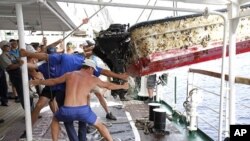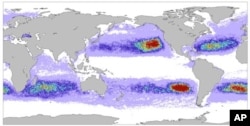A huge amount of debris from the tsunami that struck Northeast Japan more than eight months ago, appears to drifting eastward in the Pacific Ocean more quickly than anticipated.
The large and potentially hazardous debris field from Japan's March 11 tsunami is now forecast to begin coming ashore at Midway island in the Pacific as soon as December or January.
The prediction comes from the International Pacific Research Center at the University of Hawaii. Scientists revised their forecast after the tons of floating debris were spotted by a Russian vessel off Midway in late September.
Among those aboard was Nikolai Maximenko a senior researcher from the center. He and his collaborator Jan Hafner, a scientific programmer at the research center, realized the debris is moving faster than expected.
"Obviously the first pieces would be the light ones," Haffner said. "The pieces that are actually floating on the surface like empty bottles, some plastic bottles, styrofoam or maybe some wooden structures. And that would be, more or less a precursor, or a kind of warning for people on Midway that more heavy and bigger stuff is behind."
Oceanographers say the largest chunks of debris are potential hazards to navigation, marine life such as the endangered Hawaiian monk seal, reefs, beaches and facilities on the island, which is a UNESCO World Heritage Site.
Fukushima-based fishing boat found by Russian ship crew (Photo courtesy STS Pallada/Natalia Borodina)
The crew of the Russian ship spotted a Fukushima-based fishing boat, home appliances, lumber from destroyed houses and other heavy items. There could be toxic materials, as well, as entire coastal Japanese communities were swept out to sea by the tsunami.
The researchers say it is a common misconception that the debris is in a compact area, which would make it easy to track via satellites in space or other monitoring equipment. Instead, oceanographers estimate the debris field is approximately 3,700 kilometers long and 1,800 kilometers wide.
Officials of agencies responsible for the Pacific Ocean environment say they are still grappling with how to formulate mitigation plans after learning some of the mess could begin accumulating on west-facing beaches of the Hawaiian islands as soon as March, 2012.
Hafner and his colleagues are making what a best guess as to when it will also hit the West Coast of the United States and for how long it will continue to wash ashore.
"This influx of tsunami debris, it's hard to tell right now exactly the beginning and the end. But based on our kind of statistical predictions we expect to see the tsunami debris for less than one year from about September, 2013 on the West Coast," Hafner said.
The tsunami was triggered by a magnitude 9.0 earthquake off the coast of northeastern Japan on March 11.
Japanese officials say the tsunami was responsible for killing most of the 20,000 people who died in the disaster, which also triggered the meltdown of three reactors at the Fukushima-1 nuclear power plant.














